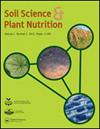Isolation and characterization of Bradyrhizobium elkanii as a root nodule symbiont of red sword bean Canavalia gladiata var. gladiata
IF 1.8
4区 农林科学
Q3 ENVIRONMENTAL SCIENCES
引用次数: 0
Abstract
ABSTRACT Bacterial strains were isolated from root nodules of red sword bean (Canavalia gladiata var. gladiata) cultivated in Shizuoka, Japan, in order to elucidate the taxonomy of the symbionts. Of the 52 bacterial isolates, 28 strains were identified as the genus Bradyrhizobium and 10 as Rhizobium, based on the nucleotide sequences of 16S rRNA genes. Nine Bradyrhizobium isolates, which were phylogenetically selected from the 28 strains, exhibited nucleotide sequences of ITS regions that were 99.9% or 100% identical with known B. elkanii strains. These nine strains shared more than 70% similarity with B. elkanii USDA 76 T or USDA 94 in DNA-DNA hybridization analysis, indicating that the strains are B. elkanii. In a nodule formation experiment using red sword bean seeds treated with mercury chloride solution, all of the plants which were inoculated with each of the B. elkanii strains (the isolate TI06 or MI08, or the type strain USDA 76 T) formed round-type root nodules (234–664 nodules per plant), while no nodules were observed in control plants that were cultivated without inoculating bacterial strains. The bacterial strains, which were isolated from the obtained nodules, exhibited nucleotide sequences of the ITS regions that were identical to those of the corresponding inoculated strains. The root nodules formed in the experiment exhibited acetylene-reducing activity, suggesting the nitrogen-fixation activity of the nodules. We thus conclude that B. elkanii is a root nodule symbiont of red sword bean.红剑豆根瘤共生体elkanii根瘤菌的分离与特性研究
摘要从日本静冈县种植的红剑豆(Canavalia gladiata var. gladiata)根瘤中分离菌株,对其共生体进行分类研究。根据16S rRNA基因的核苷酸序列,鉴定出28株为慢生根瘤菌属,10株为根瘤菌属。从28株慢生根瘤菌中分离得到的9株慢生根瘤菌ITS区核苷酸序列与已知的elkanii B.菌株具有99.9%或100%的同源性。9株菌株的DNA-DNA杂交分析结果显示,9株菌株与b.s elkanii USDA 76 T或USDA 94相似度均在70%以上,为b.s elkanii。用氯化汞溶液处理的红剑豆种子进行根瘤形成实验,接种了2株elkanii菌株(TI06、MI08和USDA 76 T型菌株)的植株均形成圆形根瘤(234 ~ 664株),而未接种菌株的对照植株均未形成根瘤。从所获得的结核中分离出的菌株显示ITS区域的核苷酸序列与相应接种菌株的核苷酸序列相同。实验中形成的根瘤具有乙炔还原活性,说明根瘤具有固氮活性。由此得出结论:绿芽孢杆菌是红剑豆根瘤共生体。
本文章由计算机程序翻译,如有差异,请以英文原文为准。
求助全文
约1分钟内获得全文
求助全文
来源期刊

Soil Science and Plant Nutrition
农林科学-农艺学
CiteScore
4.80
自引率
15.00%
发文量
56
审稿时长
18-36 weeks
期刊介绍:
Soil Science and Plant Nutrition is the official English journal of the Japanese Society of Soil Science and Plant Nutrition (JSSSPN), and publishes original research and reviews in soil physics, chemistry and mineralogy; soil biology; plant nutrition; soil genesis, classification and survey; soil fertility; fertilizers and soil amendments; environment; socio cultural soil science. The Journal publishes full length papers, short papers, and reviews.
 求助内容:
求助内容: 应助结果提醒方式:
应助结果提醒方式:


